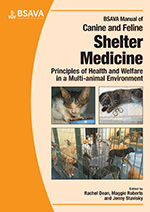
Full text loading...

It is important for veterinary surgeons to have a good understanding of feline infectious respiratory disease, since it represents a continual challenge in the shelter environment. This chapter covers: the challenge of the shelter environment, history taking, differential diagnosis, treatment, potential sequelae, prevention, outbreak management and FCV-associated virulent systemic disease. Quick reference guide: Rehoming a snotty cat.
Respiratory disease in the cat in the shelter environment, Page 1 of 1
< Previous page | Next page > /docserver/preview/fulltext/10.22233/9781910443330/9781910443330.15-1.gif

Full text loading...


















